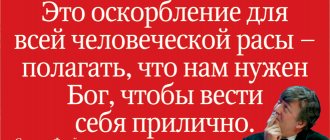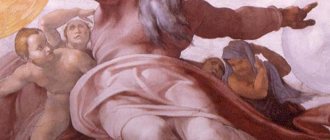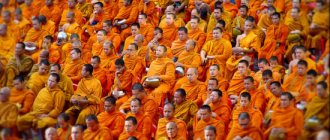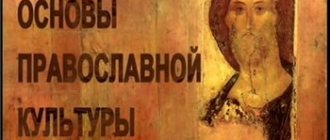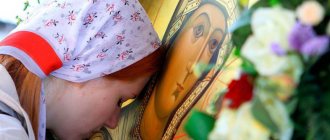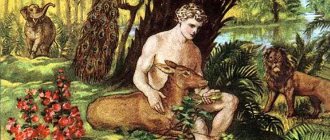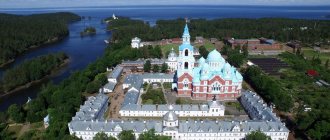Science and Faith
Do science and religion contradict each other? A clearly negative answer to this question follows from the fact that believing scientists have existed throughout human history. Even in our time of skepticism towards religion, a significant part of scientists adhere to a religious worldview. Their knowledge and logic do not prevent them from believing in the reality of the Creator. On the contrary, it is extraordinary intellect and depth of thought that often lead people of science to God.
Science and religion
Archpriest Dimitry Yurevich, speaking about the relationship between science and faith, gives the following example. A ship sailing on the ocean can be described from two different points of view. According to the first, the ship has an engine. Fuel burns in it, and the gases released set the piston in motion. He, in turn, makes the propeller work, thanks to which the ship floats.
On the other hand, without going into details of the mechanics, we can say that this ship moves because it was hired to transport cargo from one continent to another. Father Dimitri explains:
“The first description will be scientific. The second is religious. Science answers the question “why” and “how”. Religion is about the question “why.”
Orthodox writer Sergei Khudiev, answering a question about the scientific and religious pictures of the world, also says that these are two different approaches to the same thing:
“How exactly does this or that process develop?” and “By whose will, for what purpose is it developing like this?”
RADIY ILKAEV
Radiy Ilkaev - Academician of the Russian Academy of Sciences, Doctor of Physical and Mathematical Sciences, honorary scientific director of the Russian Federal Nuclear Center - All-Russian Research Institute of Experimental Physics.
He did a lot to preserve the nuclear center of our country in the 90s. The Church helped convince the authorities that the nuclear center cannot be divided. Ilkaev did not approach her lightly: the Institute was located on the former territory of the Holy Dormition Monastery of Sarov Monastery . Today nuclear scientists consider St. Seraphim of Sarov their patron, and Ilkaev himself is one of the initiators of the 2003 celebrations dedicated to the 100th anniversary of the glorification of the St.
“The most important thing in science is insight. The highest achievements of scientific thought come through insight. And this is certainly not a scientific and technical phenomenon. It is characteristic of spiritual life; it is realized and comprehended there. The history of science has a lot to do with insights. And there is no serious contradiction between the highest achievements of scientific thought and the highest achievements of spiritual life. But where does it come from - insight? It is not a consequence of any specific formula, calculation or measurement. It comes from above. This needs to be emphasized sometimes, because if you forget about this side of a scientist’s work, it actually just dilutes science.”
“This is a difficult time for science in Russia, we need to fight. And here I will allow myself one remark. The Russian Orthodox Church has enormous power these days. My personal opinion: it contains the moral basis of civil society. Her public point of view, including on science, that is, in fact, on the future intelligence of the nation, is very significant. Some officials and leaders now listen much more to the Church than to scientists. Therefore, I consider it very important to have a dialogue between the Church and science in a careful, constructive form.”
You can read about how holiness and nuclear physics are combined in the letters of Radiy Ilkaev’s colleagues about St. Seraphim of Sarov.
How science and faith complement each other
Thus, science studies only material and sensory phenomena and processes of our world. She cannot explain the root cause and meaning of these phenomena. Questions about the meaning of life and moral laws are also beyond the competence of science. It is religion that does all this. Archpriest Dimitry Yurevich notes:
“It is impossible to formulate a full-fledged worldview while remaining within the framework of exclusively scientific knowledge. Not a single experiment in the field of individual science is capable of providing answers to questions about the meaning and purpose of existence.”
Medical scientist Saint Luke (Voino-Yasenetsky) says that both science and religion are important needs of the human spirit, which are rooted in the depths of our nature. The saint teaches:
“Science poses the same questions that religion answers. According to the law of causality, it leads us to the First Cause of the world, and religion answers Who is this creative First Cause not only of the world, but also of man. Religion does not contradict science, but religion drives science.”
So, science and religion can be considered as two parallel lines (which may have a common point, but do not intersect, as evidenced by non-Euclidean geometry), and cannot come into conflict with each other, but together lead to the knowledge of God and His creation. This is exactly what Saint Gregory the Theologian, who lived back in the 4th century, had in mind when he instructed: “We must not demean learning” (“Funeral Sermon”). Therefore, those asking the question “What does science say about God?” you should know: true science has never denied the Creator, and a believer can easily agree with the scientific picture of the world.
Leonardo da Vinci believed only in his own experience, criticized dogmatism, but not God
One of the most famous scientists in human history is Leonardo da Vinci (1452 - 1519). Both atheists and believers love to refer to it. Supporters of conspiracy theories simply love to look for various signs and secret meanings, the secrets of Christianity in da Vinci’s works. But it is impossible to say unequivocally about a scientist’s attitude to faith.
Atheists like to refer to the following terms from the pen of Leonardo da Vinci:
“They will talk to people who hear nothing, whose eyes are open but do not see; they are ready to talk to them and not receive an answer; they are going to ask favor from the one who has ears and does not hear; they want to light candles for someone who is blind.”
“In all parts of Europe great nations will mourn the death of one man who died in the East.”
Leonardo da Vinci
scientist
This can be disconcerting, since da Vinci is known for his religious themes in his paintings. But even in them it is easy to detect a desire for realistic depiction and neglect of spiritual accents.
Da Vinci relied only on experience and criticized believers for dogmatism
And yet the situation is not so clear-cut. Leonardo da Vinci adhered to one very important view - he eschewed dogma. He believed in only one power - experience.
Everything outside of it is not serious and does not deserve attention. This approach allowed Leonardo da Vinci to become a great scientist.
Church dogma could not satisfy Leonardo da Vinci, since it presupposed blind faith. He criticized the dogmatic approach, the lack of living thought, and not the faith itself. And yet he tried not to talk about God. Art critic Dilshat Harman characterizes da Vinci’s attitude to spirituality as follows:
“For him, the knowledge of God does not become the head of the pyramid, does not become the cornerstone.
And this is such a new spirituality, it is a little open for further development. <…>
Because his spirituality is precisely vague, it is unclear, it is a little bit mysterious.”
Dilshat Harman
art critic
Reasons for the supposed contradictions between science and religion
The most popular “contradictions” between science and religion are simply far-fetched and the result of ignorance. For example, there is a primitive perception of religion as a naive belief in an old God sitting on the clouds. In the last century, such illustrations were actively used by the Soviet authorities in anti-church propaganda. Naturally, with this approach it was not difficult to “expose” the Church. It was enough to say that science has not found God in space.
An anti-religious argument is also widely known, declaring a conflict between scientific and biblical dates for the formation of the Universe. Like, science has proven that it took billions of years. And not at all the six days of creation described in the Bible. The reason for the existence of such primitive arguments is a superficial study of the Holy Scriptures. In the original book of Genesis, the Hebrew word “yom” is used to refer to the days of creation. It denotes not only a 24-hour day, but also any period of time. Let us also remember the words of the prophet Moses that for the eternal, timeless God, “a thousand years are like yesterday” (Ps. 89:5).
Speaking about such frivolous criticism of religion, Saint Luke (Voino-Yasenetsky) notes:
“Knowledge leads to God, half-knowledge removes from Him.”
Saint Luke sees the reason for many misconceptions in the confusion of genuine science with the private opinions of scientists:
“These opinions, reflecting not so much objective nature as the tastes of scientists, extend into that area beyond science, where there is scope for both faith and superstition.”
Finally, Saint Luke says that only those who have personal religious experience can truly judge religion:
“After all, only a person who has a musical ear or taste can judge music, and for this it is absolutely not enough to know the notes, the history of music and its theory. Unfortunately, many anti-religious writers lack this experience. And for this reason alone, their attacks on religion in its pure sense are unfounded.”
EVGENY VODOLAZKIN
Evgeny Vodolazkin is a writer, literary critic, Doctor of Philology, employee of the Department of Old Russian Literature of the Institute of Russian Literature of the Russian Academy of Sciences (Pushkin House). Specialist in the field of ancient Russian historical narrative, exegesis and hagiography. Honorary Doctor of the University of Bucharest.
“If I am mortal, then why do everything I do? This thought shook me to the core. Why do I need everything if I leave, become grass, trees? The only answer for me was faith. Moreover, what’s interesting is that I began to believe “in something” much earlier than I thought about the vanity of existence. But it was precisely faith “in something,” a kind of personal paganism. In some tense life situations, I asked for help from something... from something that I myself did not understand. And here, by the way, we can remember that man in his development repeats the path of humanity. This is how most European peoples passed from paganism to Christianity, so I made this transition at the age of sixteen.”
“I always say that there are only two points that concern a person in the world: religion and art. Nobody takes people seriously anymore. Deals with its periphery, sphere of life and other things. But they do things differently. Of course, I see hierarchical relationships here. Because religion is the highest. Art is always inferior, I say this completely calmly and without the slightest jealousy, because in its pure form only religion deals with man. But art is concerned with discovering the undiscovered, cognizing the unknown.”
Read the full text of Vladimir Legoyda’s conversation with Evgeniy Vodolazkin on the Foma website or watch the Parsuna issue.
We also highly recommend finding out what meaning Evgeny Vodolazkin put into his first novel “Laurel”.
Believing scientists: list of the most famous
What did prominent religious scientists say about God? Let us list the most famous Christian scientists who have lived in the last few centuries. That is, precisely when the religious picture of the world ceased to be obligatory and unique. People began to make their worldview choices more consciously.
Johannes Kepler . In his essay “The Harmony of the World,” the mathematician and astronomer Kepler addresses God:
“I thank You for all the joys that I experienced in contemplating Your works!”
Isaac Newton . He owns the words:
“The further a person penetrates into the secrets of nature, the more clearly the unity of the eternal plan is revealed to him.”
In an incredibly complex, but harmonious and harmonious living world, the physicist saw the work of a wise and powerful “ever-living Doer.”
Carl Linnaeus . When the naturalist and physician Linnaeus completed one of his studies, he exclaimed that it was as if an infinite and omniscient God had passed by him:
“I have not seen Him face to face; but the glimpse of the Divine filled my soul with silent wonder. I saw the trace of God in His creation...What wisdom! What indescribable perfection!”
Louis Pasteur . The chemist and biologist Pasteur admitted that he prayed during his research and was constantly amazed at the works of the Creator:
“I have studied a lot and therefore I believe like a simple peasant. If I became even more learned, my faith would become as deep and ardent as the faith of a simple peasant woman.”
Mikhail Lomonosov . The great natural scientist insisted on the benefits of a harmonious combination of science and faith. He called nature the Gospel, which solemnly proclaims the creative power, wisdom and greatness of the Lord.
Ivan Pavlov . The outstanding physiologist was a church-going Christian. He stated that, thanks to research, he was convinced of the existence of an immortal soul in man.
Max Planck . The famous physicist said that in religion God is the foundation, the beginning of all thinking, and in science - its end, its summit.
Such great scientists as Galileo Galilei, Robert Boyle, Antoine Lavoisier, Alessandro Volta, Michael Faraday, Charles Babbage, Max Born, and many others also declared their religious worldview.
Tutta Larsen
In the late 90s, the undisputed icon of Russian-language MTV was Tutta Larsen (Tatyana Romanenko), a bright, perky hooligan. The girl was terribly afraid of getting pregnant, but one day her contraception failed her, and the test showed two lines. However, Tutta quickly realized that there was nothing wrong with pregnancy, gave up bad habits and began to prepare for the birth of a child.
Tutta Larsen in her youth and now
At the eighth month, it turned out that the child had a non-viable heart defect. The pregnancy had to be terminated. At the same time, the presenter caught her husband cheating. At one point, Tutta had neither a husband nor a child. A late-term abortion led to serious complications, and the girl spent several months in a fog.
Tutta Larsen was led to faith by a homeopathic woman who helped her with her recovery. She taught the girl prayers, which really made her feel better. Later, the presenter was lucky to meet a brilliant doctor who got her back on her feet within a year. “Christ,” asserted Tutta Larsen, “gave me back the meaning of life, everything fell into place.” Returning from oblivion, Tutta became a church member. Now she is a zealous Christian, diligently observes all fasts and participates in church life.
Tutta Larsen with Valery Koloskov and son
The woman is raising a son, Luka (born in 2005), from her former common-law husband, Zakhar Artemyev, and a daughter, Marfa, and a son, Ivan, from her marriage to musician Valery Koloskov. In addition, they cemented their relationship in the face of the Lord by getting married in church.
